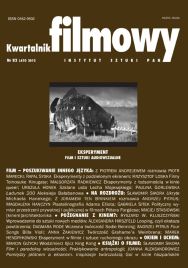Eksperyment z podzielonym ekranem.
Experiments with the split screen.
Author(s): Rafał SyskaSubject(s): Theatre, Dance, Performing Arts
Published by: Instytut Sztuki Polskiej Akademii Nauk
Keywords: split screen
Summary/Abstract: The article examines the phenomenon of split screen. Firstly Syska describes the history of analogue split screen in silent cinema when this tool was sometimes used in scenes with phone conversations, dreams and intra-diegetic film screenings. Later, the author focuses on the post-classical cinema and presents the analysis of the various forms of split screen in "Grand Prix", "The Thomas Crown Affair" or "The Boston Strangler". This special kind of screen division is observed as a consequence of dynamic narration, influence of TV-style, and experiments in media art. The third part of the essay is concentrated on contemporary, digital split screen – beginning with "Prospero’s Books" and concluding with "127 Hours" and "The Tracey Fragments". The main purpose of the article is to analyze the split screen as a response to evolution of modern ways of communication, the phenomenon of multiplication in process of information delivery and the regress of single, integrated subject in narrative methods. Split screen can be perceived as the natural form of the description of visual experiences in our time – as an equivalent of the divided composition in computer window applications, TV news, billboard system and multiplicity in contemporary communication system.
Journal: Kwartalnik Filmowy
- Issue Year: 2013
- Issue No: 82
- Page Range: 17-32
- Page Count: 16
- Language: Polish

